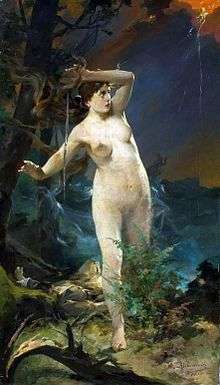Milda (mythology)
Milda, in the Lithuanian mythology, is the goddess of love.[1] However, her authenticity is debated by scholars. Despite the uncertainty, Milda became a popular female given name in Lithuania. Neo-pagan societies and communities, including Romuva, organize various events in honor of goddess Milda in May.[2] The Milda Mons, a mountain on Venus, is named after her.[3] The female figure at the top of the Freedom Monument in Riga is affectionately called Milda.[4]

Narbutt's information
Milda was first mentioned by Teodor Narbutt in his 1835 work on the history of Lithuania.[5] According to Narbutt, Milda was also known as Aleksota. Her temples stood in Aleksotas, Kaunas and in Antakalnis, Vilnius, where the Church of St. Peter and St. Paul now stands. The month of April was dedicated to Milda.[5] In a December 1835 letter to Narbutt, Szymon Ławrynowicz (a teacher from Kaunas) described two figurines found at the House of Perkūnas at the end of the 18th or beginning of the 19th centuries. Narbutt identified the figurines as those of Perkūnas, the god of thunder, and Milda.[6] Another bronze figurine was found at Vilnius Castle Complex and acquired by Adam Honory Kirkor and Władysław Syrokomla who with the help from Narbutt identified it as that of Milda. This figurine was later held at the Museum of Antiquities in Vilnius.[6]
According to Norbertas Vėlius, Narbutt invented Milda borrowing the idea of a beautiful Roman nymph Alexothe from the writings of Dominik Szybiński. As one of Kaunas' suburbs is Aleksotas, it was only natural that Milda's temple stood there. There is no evidence, either in written documents, archaeological research, or folklore, to support Narbutt's claims.[5]
After Narbutt
Narbutt's information was later repeated and popularized by many other writers and historians, including Dionizas Poška, Jonas Totoraitis, Pranė Dundulienė. However, other authors, including Aleksander Brückner, Norbertas Vėlius, Gintaras Beresnevičius, expressed serious doubts whether such goddess actually existed in the Lithuanian mythology due to lack of evidence.[5] Milda owes her popularity to Józef Ignacy Kraszewski. In 1840, he wrote Anafielas, a three-part epic poem in Polish. The first part, Witolorauda, mentioned Milda and her festival in early May. The poem was translated into Lithuanian and published several times popularizing the goddess. Its Polish publication in 1846 was illustrated with 50 woodcuts by Wincenty Smokowski.[5] His image of Milda continues to influence Milda's representations.[2] In 1918, Petras Vaičiūnas wrote a poetic play dedicated to Milda.[5]
References
- Schröder, Ingo W. (2013). Religious Diversity in Post-Soviet Society: Ethnographies of Catholic Hegemony and the New Pluralism in Lithuania. Ashgate Publishing, Ltd. p. 126. ISBN 9781409481706.
- Balsys, Rimantas (July–September 2009). "Meilės deivės Mildos autentiškumo klausimu" (PDF). Logos (in Lithuanian). 60: 151, 153–154. ISSN 0868-7692.
- "Milda Mons". Gazetteer of Planetary Nomenclature. Retrieved 2016-03-24.
- Kalnins, Ojars (August 16, 2001). "More than just a monument". The Baltic Times.
- Balsys, Rimantas (April–June 2009). "Meilės deivės Mildos autentiškumo klausimu" (PDF). Logos (in Lithuanian). 59: 133–139. ISSN 0868-7692.
- Būčys, Žygintas (2012). Senienos ir visuomenė: paveldo komunikacija XIX a. Lietuvoje (PDF) (PhD Thesis). Vilnius University. pp. 38, 129, 140–141.